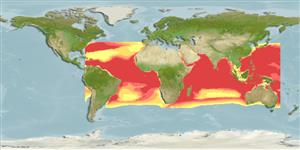Teleostei (teleosts) >
Myctophiformes (Lanternfishes) >
Myctophidae (Lanternfishes) > Diaphinae
Etymology: Diaphus: Greek, dis, dia = through + Greek, physa, phyo = to beget, to have as offspring (Ref. 45335).
Environment: milieu / climate zone / depth range / distribution range
Ecology
Marine; bathypelagic; oceanodromous (Ref. 51243); depth range 40 - 820 m (Ref. 13608). Deep-water; 40°N - 39°S, 78°W - 156°E
Tropical waters of all three oceans with extensions into higher latitudes in western boundary currents: in the Atlantic to 38°N and 39°S; in the western Pacific to 26°N. Eastern Atlantic: from about 4°N to about 13°S, with some records at about 20°N, but absent over the Mauritanian Upwelling Region.
Length at first maturity / Size / Weight / Age
Maturity: Lm ?, range 8 - ? cm
Max length : 10.5 cm SL male/unsexed; (Ref. 4479)
Oceanic species occurring between 375-750 m during the day and between 40-225 m at night.
Reach sexual maturity at 7,6 cm (Ref. 47377).
Life cycle and mating behavior
Maturity | Reproduction | Spawning | Eggs | Fecundity | Larvae
Hulley, P.A., 1990. Myctophidae. p. 398-467. In J.C. Quero, J.C. Hureau, C. Karrer, A. Post and L. Saldanha (eds.) Check-list of the fishes of the eastern tropical Atlantic (CLOFETA). JNICT, Lisbon; SEI; Paris; and UNESCO, Paris. Vol. 1. (Ref. 4479)
IUCN Red List Status (Ref. 130435: Version 2024-1)
Threat to humans
Harmless
Human uses
Tools
Special reports
Download XML
Internet sources
Estimates based on models
Preferred temperature (Ref.
123201): 9.9 - 20.4, mean 14.9 °C (based on 603 cells).
Phylogenetic diversity index (Ref.
82804): PD
50 = 0.5000 [Uniqueness, from 0.5 = low to 2.0 = high].
Bayesian length-weight: a=0.00759 (0.00328 - 0.01756), b=3.02 (2.83 - 3.21), in cm total length, based on LWR estimates for this Genus-body shape (Ref.
93245).
Trophic level (Ref.
69278): 3.0 ±0.00 se; based on food items.
Resilience (Ref.
120179): High, minimum population doubling time less than 15 months (Preliminary K or Fecundity.).
Fishing Vulnerability (Ref.
59153): Low vulnerability (10 of 100).
